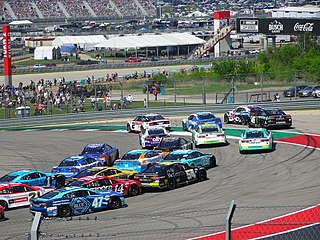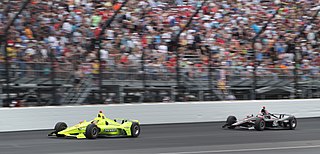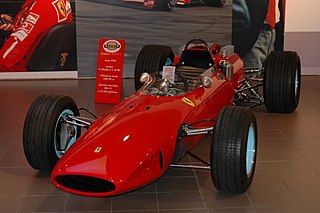
Auto racing is a motorsport involving the racing of automobiles for competition. In North America, the term is commonly used to describe all forms of automobile sport including non-racing disciplines.
Formula One, commonly known as Formula 1 or F1, is the highest class of international racing for open-wheel single-seater formula racing cars sanctioned by the Fédération Internationale de l'Automobile (FIA). The FIA Formula One World Championship has been one of the world's premier forms of racing since its inaugural running in 1950. The word formula in the name refers to the set of rules all participants' cars must follow. A Formula One season consists of a series of races, known as Grands Prix. Grands Prix take place in multiple countries and continents on either purpose-built circuits or closed public roads.
Motorsport(s) or motor sport(s) are sporting events, competitions and related activities that primarily involve the use of automobiles, motorcycles, motorboats and powered aircraft. For each of these vehicle types, the more specific terms automobile sport, motorcycle sport, power boating and air sports may be used commonly, or officially by organisers and governing bodies.

The Spanish Grand Prix is a Formula One motor racing event currently held at the Circuit de Barcelona-Catalunya. The race is one of the oldest in the world still contested, celebrating its centenary in 2013. The race had modest beginnings as a production car race. Interrupted by the First World War, the race waited a decade for its second running before becoming a staple of the European calendar. In 1927 it was part of the World Manufacturers' Championship; it was promoted to the European Championship in 1935 before the Spanish Civil War brought an end to racing. The race was successfully revived in 1967 and has been a regular part of the Formula One World Championship since 1968 at a variety of venues.

Road racing is a North American term to describe motorsport racing held on a paved road surface. The races can be held either on a closed circuit or on a street circuit utilizing temporarily closed public roads. The objective is to complete a predetermined number of circuit laps in the least amount of time, or to accumulate the most circuit laps within a predetermined time period. Originally, road races were held almost entirely on public roads. However, public safety concerns eventually led to most races being held on purpose-built racing circuits.

The Trans-Am Series presented by Pirelli is a sports car racing series held in North America. Founded in 1966, it is sanctioned by the Sports Car Club of America (SCCA). Primarily based in the United States, the series competes on a variety of track types including road courses and street circuits. Trans-Am is split into the TA and TA2 classes for silhouette racing cars, while its production classes are the GT, SGT, and XGT.

Gioacchino Colombo was an Italian automobile engine designer.
Dirt track racing is a form of motorsport held on clay or dirt surfaced oval race tracks often used for thoroughbred horse racing. Dirt track racing started in the United States before World War I and became widespread during the 1920s and 1930s using both automobiles and motorcycles. Two different types of race cars dominate — open wheel racers in the Northeast and West and stock cars in the Midwest and South. While open wheel race cars are purpose-built racing vehicles, stock cars can be either purpose-built race cars or street vehicles that have been modified to varying degrees. There are hundreds of local and regional racetracks throughout the nation. The sport is also popular in Australia, New Zealand, Canada, South Africa and the United Kingdom.

American open-wheel car racing, generally known as Indy car racing, or more formally Indianapolis car racing, is a category of professional automobile racing in the United States. As of 2024, the top-level American open-wheel racing championship is sanctioned by IndyCar. Competitive events for professional-level, open-wheel race cars have been conducted under the auspices of various sanctioning bodies, tracing its roots as far back as 1902. A season-long, points-based, National Championship of drivers has been officially recognized in 1905, 1916, and each year since 1920. As such, for many years, the category of racing was known as Championship car racing. That name has fallen from use, and the term Indy car racing has become the preferred moniker.

Formula 5000 was an open wheel, single seater auto-racing formula that ran in different series in various regions around the world from 1968 to 1982. It was originally intended as a low-cost series aimed at open-wheel racing cars that no longer fit into any particular formula. The '5000' denomination comes from the maximum 5.0 litre engine capacity allowed in the cars, although many cars ran with smaller engines. Manufacturers included McLaren, Eagle, March, Lola, Lotus, Elfin, Matich and Chevron.

Formula racing is any of several forms of open-wheeled single-seater motorsport. The origin of the term lies in the nomenclature that was adopted by the FIA for all of its post-World War II single-seater regulations, or formulae. The best known of these formulae are Formula One, Formula E, Formula Two, Formula Three, regional Formula Three and Formula Four. Common usage of "formula racing" encompasses other single-seater series, including the IndyCar Series and the Super Formula Championship.

Richard Leroy Trickle was an American race car driver. He raced for decades around the short tracks of Wisconsin, winning many championships along the way. Trickle competed in the ASA, ARTGO, ARCA, All Pro, IMCA, NASCAR, and USAC.
The Atlantic Championship Series is an American open-wheel racing series with races throughout North America. It has previously been called Champ Car Atlantics, Toyota Atlantics, or just Atlantics

Sydney Motorsport Park is a motorsport circuit located on Brabham Drive, Eastern Creek, New South Wales, Australia, adjacent to the Western Sydney International Dragway. It was built and is owned by the New South Wales Government and is operated by the Australian Racing Drivers Club. The circuit is one of only two permanent tracks in Australia with an FIA Grade 2 license and is licensed for both cars and motorcycles.

The Alfa Romeo 158/159, also known as the Alfetta, is a Grand Prix racing car produced by Italian manufacturer Alfa Romeo. It is one of the most successful racing cars ever; the 158 and its derivative, the 159, took 47 wins from 54 Grands Prix entered. It was originally developed for the pre-World War II voiturette formula (1937) and has a 1.5-litre straight-8 supercharged engine. Following World War II, the car was eligible for the new Formula One introduced in 1947. In the hands of drivers such as Nino Farina, Juan Manuel Fangio and Luigi Fagioli, it dominated the first two seasons of the World Championship of Drivers.

The Maserati 4CL and its derived sister model the Maserati 4CLT are single-seat open-wheel Grand Prix racing cars that were designed and built by Maserati. The 4CL was introduced at the beginning of the 1939 season, as a rival to the Alfa Romeo 158 and various ERA models in the voiturette class of international Grand Prix motor racing. Although racing ceased during World War II, the 4CL was one of the front running models at the resumption of racing in the late 1940s. Experiments with two-stage supercharging and tubular chassis construction eventually led to the introduction of the revised 4CLT model in 1948. The 4CLT was steadily upgraded and updated over the following two years, resulting in the ultimate 4CLT/50 model, introduced for the inaugural year of the Formula One World Championship in 1950. In the immediate post-war period, and the first two years of the Formula One category, the 4CLT was the car of choice for many privateer entrants, leading to numerous examples being involved in most races during this period.

The Ferrari 158 was a Formula One racing car made by Ferrari in 1964 as a successor to the V6-powered Ferrari 156 F1.

Rockford Speedway was a 1/4 mile short track high banked asphalt oval located in Loves Park, Illinois on Illinois Route 173. Rockford Speedway, Chicagoland Speedway, and World Wide Technology Raceway at Gateway are the only racetracks running under NASCAR sanctions in Illinois.
The 1946 AAA Championship Car season was the first season of American Championship car racing following World War II. After four years without automobile racing in the United States, the AAA Contest Board was initially concerned about having enough races, enough entrants, and suitable equipment, to contest season on such short notice for 1946. Even the Indianapolis 500 was in doubt, as the Indianapolis Motor Speedway had been fallen into a terrible state of neglect during the war years.













